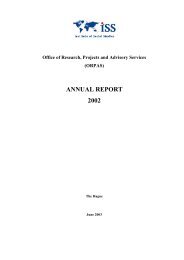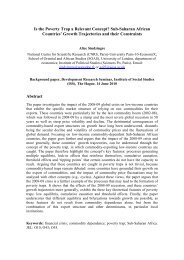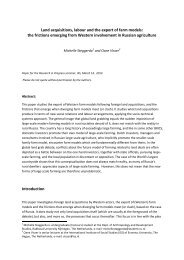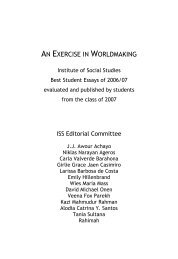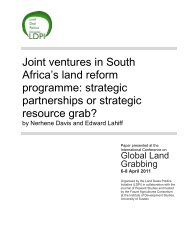AN EXERCISE IN WORLDMAKING 2009 - ISS
AN EXERCISE IN WORLDMAKING 2009 - ISS
AN EXERCISE IN WORLDMAKING 2009 - ISS
Create successful ePaper yourself
Turn your PDF publications into a flip-book with our unique Google optimized e-Paper software.
17 Intersectionality and Human Rights: Law, Theory and Praxis 203<br />
from an ethnic, religious or cultural group in which her marital status is<br />
an integral part of her survival (more so than in many secular societies),<br />
or if she is disabled or cannot speak the dominant language/s of the<br />
country in which she currently resides. Conventions which are aimed at<br />
providing protection to undocumented migrants, but which fail to recognise<br />
the particular positioning of a woman migrant, perhaps a woman<br />
who is not heterosexual, not married, or not young, for example, become<br />
documents which offer procedural justice but little substantive protection.<br />
The same can be said of programmes, civic organisations or international<br />
multilateral agencies, which aim to provide assistance to survivors<br />
of sexual violence. The way a woman experiences violence not only differs<br />
from the way a man may experience it, but factors like economic<br />
status, sexual orientation, race and ethnicity all play a significant part in<br />
how she experiences the violence, as well as the causal factors that led to<br />
it (such as “corrective” rape for lesbians as opposed to the systematic<br />
sexual assault of women during violent conflicts). The way that these<br />
programmes and organisations approach violence and the survivor, how<br />
they frame solutions to the problem and which strategies they adopt to<br />
promote victim empowerment, can be significantly improved through<br />
the application of an intersectional framework, as services and support<br />
can recognise and accommodate her specific needs based on her particular<br />
location.<br />
Secondly, intersectionality has the potential to highlight the multiple<br />
dimensions of political and social exclusion by asking the right questions,<br />
such as: how do the multiple identities of individuals or communities<br />
emphasise or intensify the way that they experience injustice? How do<br />
reformist politics on one issue (such as gender) (re)enforce the subordinating<br />
and exclusionary aspects of another issue (such as race)? How do<br />
current human rights theories and practices exacerbate social exclusion<br />
through their denial of intersectionality?<br />
The multiple positioning of identity results in a multi-dimensional experience<br />
of exclusion. If identity politics and theory fail to take this into account,<br />
they relegate the identity and the differing experiences of exclusion<br />
to a place of irrelevance or complete denial. In other words, it is not only<br />
that human rights praxis can be improved through a clearer understanding<br />
of the nature of oppression, but it is also true that theory and praxis that<br />
fail to employ an intersectional framework runs the risk of excluding some




